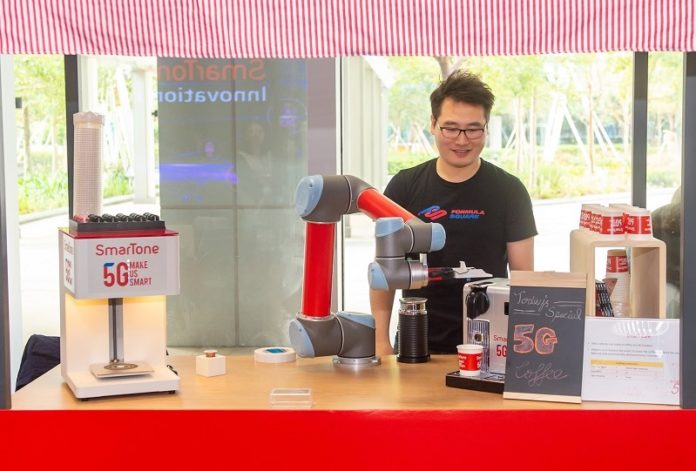For most people, 5G is typically pitched as a consumer product – specifically, as a glorified 4G upgrade. But the real value of 5G could be realized by the enterprise sector – or at least, that’s what mobile operators like Hong Kong’s SmarTone are hoping.
Two years ago, SmarTone opened its 5G Innovation Hub to invite enterprises, apps developers and entrepreneurs to come in and play in their 5G sandbox to come up with enterprise use cases for 5G that don’t involve making smartphones download videos faster.
In late January, SmarTone invited media to a demo of some of the things the Innovation Hub has been working on. The centrepiece was its “SmarT Works” IoT-based industrial safety solution for the construction industry, which uses IoT sensors on safety helmets to not only track the location of workers on a construction site and monitor vital signs and environmental conditions, but also detect when a worker has fallen down (thus indicating a possible accident).
Other enterprise-targeted 5G solutions on display included:
- 5G-connected ambulances that allow doctors to provide remote assistance to treat patients while they’re en route to the hospital. For example, paramedics could perform an ultrasound procedure using a special haptic glove that the doctor can view back in the A&E in real time. The doctor could also control the glove using a joystick.
- 5G-connected drones performing inspections of large industrial sites such as theme parks and oil refineries. The drones, equipped with HD cameras, can beam back live video of infrastructure to check for rust, leaks or other kinds of damage, or search for unauthorized personnel on the grounds (say, theme park guests who fail to leave at closing time).
- Augmented reality t-shirts, in which someone could view your shirt via an AR app to see an entirely different image or a promotional video.
- 5G-powered robot baristas that can whip up a cappuccino with a personalized chocolate-powdered image printed in the foam (to include photos – no, really).

In each of these cases, the common thread is the ability of 5G to deliver the capacity, the data speeds and – more importantly – the latencies necessary to make these apps possible. That’s key because technically the other technologies involved in these apps (IoT, tracking, AI, robotics, AR, etc) are not future tech – they exist today. But while wireless technologies exist to connect them, none of them enable the low-latency capabilities of 5G.
That’s why in Europe, big-name car manufacturers like Audi are jumping on the 5G bandwagon early, looking at 5G to supplement or even replace Wi-Fi as the campus wireless broadband tech of choice in their factories and work areas in the name of Industry 4.0.
Operators like SmarTone aim to show that the opportunities for 5G in the enterprise are much broader than smart factories, whether you’re an entrepreneurial startup or a traditional business like construction.
The basic criteria, says SmarTone CEO Anna Yip, is to look at what what particular pain points an enterprise might have, and how 5G might solve it.
“No one will fund new technology just for the sake of it – it has to solve a problem that other technologies can’t, or can’t do as well,” Yip says. “It might be about lowering costs or doing certain things that humans can’t do, like drone inspections over a huge area because it’s logistically impossible or unsafe for humans to do it themselves.”
As an example, one reason the construction industry is keen on a 5G-powered monitoring app is because industrial safety is crucial – not just in terms of keeping employees safe, but in terms of keeping the project on schedule.
“Industrial safety is a major pain point for construction companies, because if there’s an accident and someone gets injured or killed, everything stops for the investigation for at least four days, and it’s big cost for the construction company,” Yip explains.
In Hong Kong, for example, a major cause of casualties is heatstroke because of Hong Kong’s tropical climate. “Workers are at risk for heatstroke – they faint from the heat and if it takes more than 30 minutes to find them, they could die. So that’s why the low latency and the high speed data transmission capacity are crucial to help monitor the whole site.”
One obvious prerequisite for enterprises adopting 5G enterprise services is actually having a commercial 5G service available in the first place. For now, at least, that’s a big barrier in most markets (including Hong Kong) – in Asia, 5G is commercially available only in South Korea and China. And even then, coverage is limited to bits of busy urban centers, and mainly as a consumer service.
That may start to change this year – 2020 is, after all, the initial target year for 5G services in early-adopter markets like Japan, Singapore and Hong Kong. But even when 5G launches, most enterprises can only leverage it if their office or shop happens to be in a coverage zone.
On the other hand, says SmarTone chief technology officer Stephen Chau, for enterprises who want 5G, it won’t be difficult for SmarTone to provide coverage for their location on demand.
“Many enterprise solutions aren’t dependent on citywide or nationwide 5G coverage, because you can deploy coverage onsite quickly and relatively cheaply,” Chau says, though he adds that in the case of Hong Kong’s densely packed urban canyons, citywide coverage won’t take long to achieve.
SmarTone plans to launch 5G services by the middle of this year, and expects to cover 78% of the population within 12 months.
In any case, Chau says, enterprise 5G will is more likely to happen after the network becomes available, because while 5G sandboxes like the Innovation Hub can allow enterprises to explore possible use cases, it’s only after the network goes live in the real world that enterprises will really be able to figure out what they can do with it.
“It’s not just about 5G itself – it’s the peripheral technologies like IoT and AI that enterprises are also looking at,” Chau says. “So It’s not really just about 5G itself magically transforming the business – it’s all these elements coming together and 5G being an enabler to bring these capabilities that the earlier generations don’t have.”
















